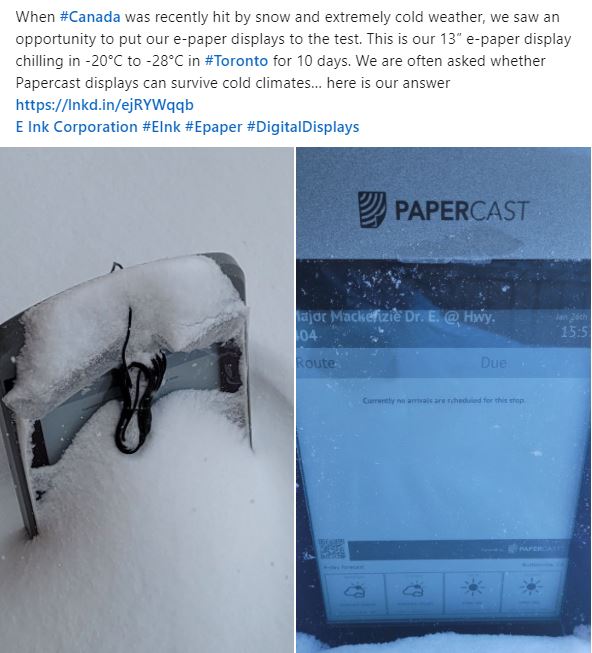
Papercast @ ISE 2025: 4-7 February 2025, Barcelona
Visit Papercast on Booth 4D280 on 4-7 February 2025 Discover Papercast’s cutting-edge e-paper passenger information…

Welcome to the second in a series of blogs where we tackle the big questions we hear when we first discuss Papercast® as a solution. We started with energy efficiency last month, here we look at our impressive operating temperature range.
There is a lot of discussion around the viability of outdoor displays, particularly whether a screen can withstand extreme temperatures. That’s why we are asked how Papercast displays cope in really hot or cold climates.
The truth is that our displays are exceptionally stable in extreme environments, able to withstand the excessive heat of summers in the Middle East to the sub-zero temperatures and long winters of the Northern Hemisphere. Our certified external temperature range is -20°C to +70°C / -4°F to +158°F, but we have recorded temperatures in display locations that tip below this range.
Working within the limits of E Ink® screen technology, Papercast has spent considerable effort developing, optimizing and testing methods to achieve the best viewing performance under low and high temperature conditions. This has been achieved without excessive power use and our smart algorithms achieve the required balance.
We have also invested in ruggedized IP68 rated enclosures – durable enough to stand up to the vagaries of nature, be it extreme heat, cold, heavy rain, slush, sand and so on. In short, it can survive almost anything you throw at it.
Let’s take a look at how things stand at the far ends of the temperature range.
Papercast has conducted extensive testing to validate low temperature operation and device durability for deployments in freezing environments, and this social post caught a lot of attention recently:

We exposed our 13” e-paper display to the extremely cold weather that recently swept across Canada. It remained functional and effective even in temperatures as low as -28°C / -18°F while continuing to show important public messages in real-time.
But nothing speaks louder than a live customer deployment.
Last year we completed a proof of concept trial in Finland which formally became the first ever solar powered passenger information initiative in the Nordics, where temperatures drop below -25°C / -13°F with very short periods of sunlight in the middle of winter.
Ilpo Pulli, CEO of Sx3-Group Oy: “In the Nordic countries, the coldness of winter and low sunlight create challenges for charging batteries with photovoltaics. However, the power consumption of Papercast e-paper displays is so low that we have now been able to overcome this hurdle for the very first time”.
This performance is rare in Finland’s latitudes throughout the Nordic region, where bus stop screens are mains powered, and points to the exceptional energy efficiency of our displays (as we explored in the first blog of this series).
For as many cold climate questions, we have hot climate ones. Much of these have originated from the Middle East region where the average temperature during the summer months is around 40°C / 105°F, but we have recorded peak temperatures close to 50°C / 120°F (with the display internal temperature tipping 70°C / 160°F). There is also sand to consider (a lot of it) and humidity during the summer months in coastal areas.
Our first high temperature project dates back to 2017 in Kuwait, marking a debut for solar powered e-paper technology in the GCC states. The displays performed during 6-months of testing with daily temperatures exceeding 48°C with severe sand storms.
We have since installed displays in Dubai, Qatar, Makkah and Abu Dhabi:
Mr. Aspi Kapadia, Vice President of Energy International: “Implementing a fast and reliable channel for providing real-time information to the public at bus stops was the next logical step for Abu Dhabi. The sunlight readable, solar powered e-paper displays from Papercast offered the most effective solution – without the need to pull power and data cables. Wirelessly connected to the Papercast content management system, the DoT is able to easily control the display content.”
Demonstrating that Papercast displays can withstand the demands of the harshest environmental conditions.
We can safely conclude that Papercast outdoor e-paper displays can operate pretty much anywhere… From the extremely cold northern climates to the blistering heat (and dust) of the desert, and everything in between. The technology can cope from a durability perspective, and the energy efficient nature of our displays allows them to operate in conditions with low sunlight.
Robert Bicket, CEO at Papercast: “Papercast offers the most technically advanced bus stop passenger information display solution in the world. Every aspect of our hardware, firmware, software and support is developed and managed in-house, resulting in a robust and resilient solution for even the most extreme outdoor environments”.
Is there anywhere that Papercast can’t go? We address this question in the next blog in the series, Your big questions: How do we power Papercast® e-paper displays?

Visit Papercast on Booth 4D280 on 4-7 February 2025 Discover Papercast’s cutting-edge e-paper passenger information…

Visit Papercast on Booth 353 on 29 September – 2 October 2024 Discover Papercast’s cutting-edge…